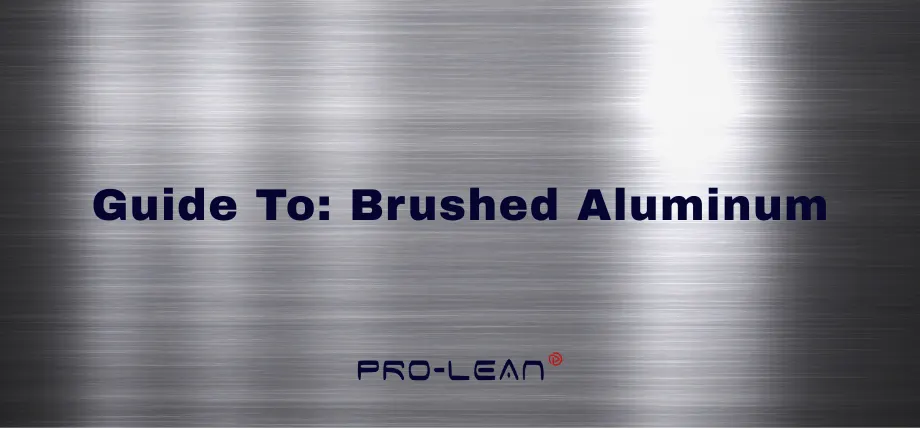
Brushed aluminum finish is one of the most popular aluminum finishes for decorative, electronic, and commercial applications. You can identify brushed aluminum from lines going across the shiny metal surface. But how exactly is brush finish achieved? And why is it so popular?
A brushed finish has a rough surface; this is useful for hiding abrasion marks and scratches and is a more durable finish for items like suitcases and phone bodies.
This guide explores the process of brush-finishing, the advantages of brush-finished aluminum parts and common alloys for surface finishing.
What Is Brushed Aluminum?
There are many aluminum finishes like anodizing and alodining or powder coating. Brushed aluminum is aluminum with a surface that has unidirectional lines (or grains).
Brushed aluminum does not reflect the same amount of light as polished aluminum, and the grooves give it a distinct look. Brushed aluminum has the same properties as polished aluminum–it is lightweight, corrosion-resistant, strong, and provides an aesthetic appearance.
How Is Brushed Finish Achieved?
A brushed finish on aluminum and other metals is achieved using mechanical processes.
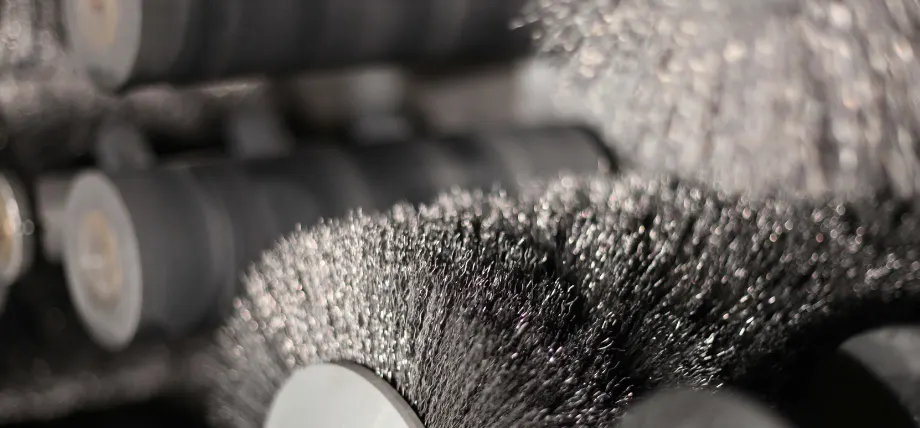
Aluminum brushing tool
Mechanical Brushing: Step-by-step Process
Prepare The Surface
Before mechanical abrasion can be performed on any aluminum surface, it has to be cleaned. Aluminum can be cleaned using many solvents, but alkaline-based cleaners like Simple Green’s aluminum degreaser can remove most impurities, dirt, and cutting fluids, leaving behind an even aluminum surface.
You can also sand the aluminum surface to remove any prior coatings and tough marks.
Abrasion
There are many ways to get the brushed finish for your project. The linear grain is achievable using a host of abrasive tools, but the best finish is achieved using a CNC service with surface finishing capability.
Wire Brush: The manual way to achieve a brushed finish is by using a stainless steel wire brush mounted on a belt or rotating wheel like a handheld grinder. The tough wires scratch the aluminum surface in one direction forming fine patterns and fine lines.
Abrasive Pad: Another way to achieve a brushed finish is by using sandpaper or a high-grit abrasive pad (120 grit – 240 grit) to scratch the aluminum surface. Abrasive pads are sometimes used progressively to get a finer brushed texture on the aluminum.
CNC Machining: CNC machines similar to CNC grinders are capable of providing a brushed finish on aluminum parts. These automated machines can produce multiple brushed finished aluminum parts using abrasive rollers.
The advantage of CNC machines for brushed texture is consistent grain on all parts, larger volumes, and an efficient brushing process for metals.
Unlike manual brushing and abrasive pads, CNC machines can maintain uni-directional patterns in continuous abrasive roller passes. Any circular motion or approaching the surface from a different angle can disrupt the texture.
Cleaning Brushed Finish Aluminum
The next step is to clean the brushed finish aluminum. Tiny aluminum bits need to be removed from the grooves and improve the grainy texture.
Post Processing
Brushed-finish aluminum can undergo further processes like anodizing, painting, chem film coating, or polishing. Anodizing improves corrosion resistance and can also color the surface.
Try Prolean Now!
Benefits of Brushed Finish
Durability
Brushed finish aluminum does not alter the physical or mechanical properties of aluminum. However, brushed aluminum is used in architectural trims and outdoor frames. Brushed aluminum hides any scratches, light abrasions, and wear compared to polished surfaces.
Often, brushed aluminum is anodized to add an extra layer of protection for outdoor uses which increases its durability and corrosion resistance.
Aesthetic Appeal
Brushed, satin finish is used in modern design because it complements the appearance and is easy to do straight from the factory. It also serves another function: hiding oil marks and fingerprints.
Fine-grain satin finish can hide smudges easily and is used in consumer electronics.
Conceals Scratches
Brushed aluminum can hide unwanted scratches from keys, weathering, or overtime wear. On door handles and enclosures, it can help the surface maintain its finish and prolong first repairs.
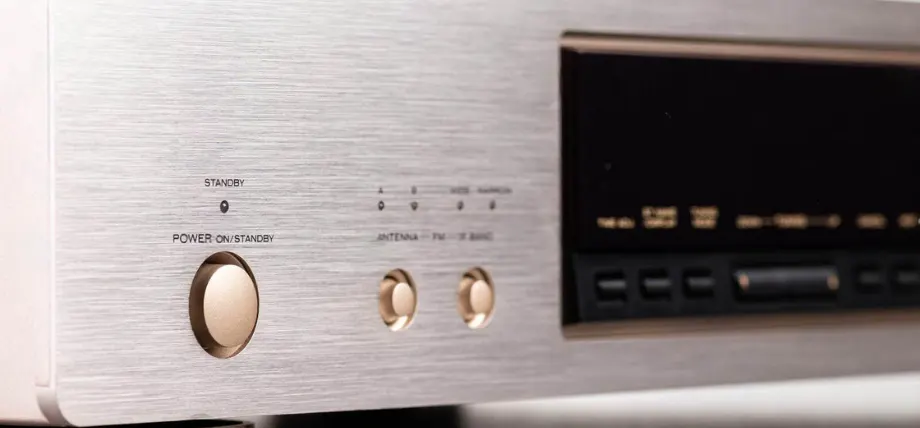
Title: Brushed finish on kitchen appliance
Non-reflective
The surface finish is non-reflective making it useful for outdoor applications and reducing glare. Brushed aluminum is a popular material finish for signage.
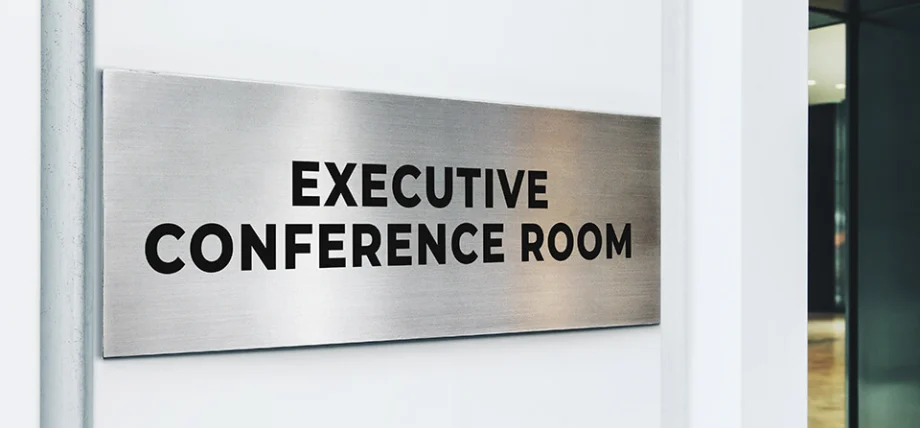
Title: Aluminum brushed finish signage
Cons of Brushed Aluminum
Sterilization Issues
Bacteria and microbes can grow in the fine grain, especially if brushed aluminum is used in kitchen and cookware. Brushed aluminum requires deeper cleaning with mild soap or a cleaning agent occasionally.
Costlier
The brushed finish is an extra surface finishing process for aluminum parts, which adds cost to the overall aluminum fabrication process.
Difficult To Repair
If the aluminum surface is damaged from an impact, it is difficult to restore the exact grain texture.
Try Prolean Now!
How To Maintain Brushed Aluminum
Regularly Clean Brushed Aluminum
Brushed aluminum can become dull over time with constant use and dirt. However, you can usually clean brushed aluminum using a cleaning rag or microfiber towel. When wiping the aluminum, use a cleaning motion in the direction of the grain.
You can also use cleaning wipes and alcohol to remove oils and dirt, especially if the aluminum part is a door handle or kitchen appliance.
Dry completely after wiping with a damp cloth to avoid corrosion.
Avoid Scratching
Brushed aluminum is good at hiding scratches, but deeper scratches against the grain can still show. You can avoid scratching aluminum by
- Using cases
- Avoiding placing items on top of the aluminum
- Avoiding abrasive sponges and harsh brushes during cleaning.
Use Protective Layer For Brushed Aluminum
You can also use an anodizing layer on your part. Anodized brushed finish aluminum is tougher, more corrosion resistant, and has increased wear resistance.
Anodized aluminum can be used in outdoor applications, moisture environments, and industrial places.
Most Common Brushed Aluminum Alloys and Applications
Brushed Finish 6061 Aluminum
6061 aluminum is a common aluminum grade for structures and aerospace components. It has good corrosion resistance and weldability.
It can easily take on a brushed finish for scratch resistance in electronics and architectural applications.
Brushed Finish 6063 Aluminum
6063 is the most common aluminum grade for architectural applications. It has good extrudability and surface finish. The brushed finish is applied to 6063 alloys for decorative purposes on architectural trims, furniture, and curtain walls.
Brushed Finish 5052 Aluminum
Aluminum 5052 is used in signage and marine applications, such as boat railing or accent trims on smaller boats. 5052 aluminum sheets are brushed finished before sheet metal fabrication processes like stamping and bending create panels.
Aluminum Alloy 3003
Aluminum 3003 has applications in kitchen appliances, pots, and ductwork, and a brushed finish is mainly used for aesthetic reasons.
Brushed Finish Aluminum Vs Polished Aluminum

Title: Polished reflective aliminum
Polished aluminum has a mirror-like reflective surface that is normally achieved using a process called buffing and polishing. Polished aluminum reflects light extremely well. Choosing between polished or brushed aluminum depends on your aesthetic requirements.
Here is a comparison that can help you decide:
Durability
Brushed aluminum is more durable against scratches and is used every day. Polished aluminum can quickly collect scratches and even tarnish with time. Polished aluminum coatings like lacquer can protect it against everyday wear.
Corrosion Resistance
Brushed aluminum has better corrosion resistance than polished aluminum. Both materials are aluminum, but mostly brushed aluminum has an anodized layer, while polished aluminum has a clear coat, which is not as effective against corrosion.
Surface Treatment Cost
Polishing aluminum is a more tedious process that requires grinding and buffing. Grinding operations are expensive and can quickly rack up into the costs of aluminum machining. Surface treatment costs vary depending on the roughness value, protective coating and finer brushing.
When To Use Polished Aluminum Finish?
Polished aluminum is used when you need reflectivity or a lustrous finish. For example, polished aluminum is used in lighting fixtures and lining solar reflectors.
It is also used in decorative items and inside buildings to add sophistication and in retro designs where a chrome like finish is needed at a fraction of the price.
Surface Treatment Service For Aluminum Parts
Improve your aluminum parts with our premium surface treatment services for aluminum. Pro-lean tech is a one-stop solution for machining aluminum parts and surface finishing services that include:
- Anodizing
- Polishing
- Brushing
- Chem Film
And more.
Contact us today for a free quote.
Conclusion
Brushed finish aluminum is an extremely popular finish that is found on everyday items like electronics and aerospace components. You can easily brush finish your aluminum parts using wire brushes, or CNC machines.
It offers a durable and scratch-resistant finish to aluminum surfaces and is commonly used in sheet metal parts.
FAQ
What is brushed aluminum?
Brushed aluminum has a surface with uni-directional grain patterns formed using a wire brush or abrasive pads.
How to get a brushed finish on aluminum?
You can achieve a brushed finish on aluminum using a wire brush at home. For small parts, you can use a steel brush, and for larger parts, you can use a rotating wire brush, but this requires careful manual control
Is brushed aluminum anodized?
You can anodize your brushed finish aluminum part and extend its life against corrosion.
Is brushed aluminum good?
Brushed aluminum has better durability than regular aluminum and anodized brushed aluminum has better corrosion resistance and wear resistance, improving its mechanical properties.

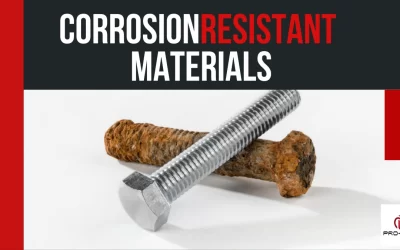
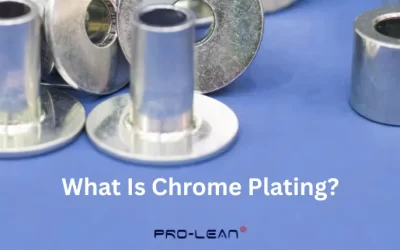
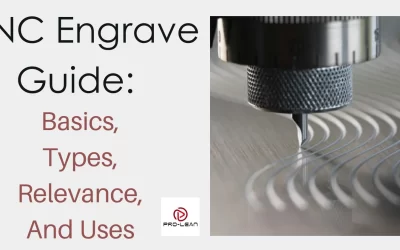
0 Comments